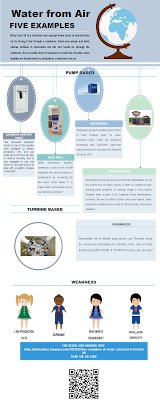Video Link : https://youtu.be/AVQJCH-6psg
Water from Air is a new concept for the conservation of water by adopting a source that is uncommon and renewable. The most abundant source of freshwater is the Earth’s atmosphere. When atmospheric humidity condenses, it falls as rain. This natural process of condensation is replicated by adopting different technologies, which allows it to make water continuously, even in low humidity conditions.
Here are the examples :
1)Airowater Dewpoint Smart
"The Airowater Dewpoint Smart is one of the smaller units designed to ensure portability. This unit can make up to 20 litres per day in relative humidity and is also equipped to use city water as the input source to deal with a sudden increase in demand!"
2)Rainmaker
"Rainmaker’s Air-to-Water units produce drinking water from the air – no other water source is required. " It uses a turbine that forces air through a heat exchanger, where the air is cooled and condensation takes place. A hybrid solution (solar/wind/grid) is deployed for forcing the air into the heat exchanger. The temperature of the air is lowered in the exchanger to produce water drops which are collected in a container. Rainmaker Air-to-Water application, can "harvest water by combining atmospheric humidity, heat, and air flow producing 5,000, 10,000 or 20,000 liters per unit, per day."
3)Akvo AWGs
"The most abundant source of fresh water is the Earth’s atmosphere. When atmospheric humidity condenses, it falls as rain. Akvo® replicates this natural process of condensation by simulating the dew point, which allows it to make water continuously, even in low humidity conditions. Our unique technology uses optimized dehumidification techniques to extract and condense moisture in the air to produce healthy purified drinking water."
4) Watergen
"Watergen is the pioneering Israeli company that has become the global leader in the atmospheric drinking water devices (AWG) market, machines that create drinking water from the air. The company’s solutions are the most effective and economical way to solve the pressing issue of drinking water scarcity in any location and at any time, and also enable the elimination of carbon-intensive supply chains and environmentally-harmful plastic waste.
Watergen’s products produce up to 5 liters of fresh drinking water by water extraction using 1 KWH. The company’s technology also facilitates significant water production in climates with humidity as low as 20%."
5)Watermaker
"Atmospheric Water Generators (AWGs) in India, could provide clean and healthy drinking water amounting from 120 liters to 5000 litres per day. We also export these WaterMakers (AWGs) to many other countries,” says Meher."
Most of the air to water systems that are available in the market use the condensation of air phenomena. The atmospheric air is passed through freezing surfaces such that air moisture will be condensed and collected as water drops, in a collector.
The air to water system is used for water production in water-scarce areas of the World. Around 1liter or more water can be prepared within 2 hours depending on the amount of moisture available for use.
However, the major drawbacks of the systems are the "low rate of production","the manufacturing cost of the system", energy requirement, and installation complexities. That is why, both the duration required to produce water from the moisture and also the cost of production, deter customers from wide-scale utilization of the systems.
So further research may be conducted in this aspect.
Thanking you,
@Mrinmoy
Founding and Honorary Editor
Data Science in Sustainability
Publish your book with EIS Publishers
Promoted Products:
"Ashwagandha and Other Products for Enhancing Immunity".. Nutrilite(Use 13238584 as ABO ID)
Procure Hydrology Themed T-Shirts from Innovate S
Images collected from the Product Website of Air to Water Systems.
Quotes within double inverted commas are collected from the Product Websiteof Air to Water Systems.




